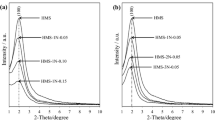Abstract
The objective of this work is the synthesis of highly functionalized hybrid organic/inorganic materials by the polycondensation of bis[3-(trimethoxysilyl) propyl]amine in the presence of surfactants. High contents of amine groups were achieved by carrying out the syntheses without an inorganic cross-linker. The silsesquioxanes obtained had a mesoporous structure. The stability of their porous system in the absence of an inorganic cross-linker was enhanced by the precursor’s bridged structure. The material structures were studied by FT-IR spectroscopy, Porosimetry, X-Ray Diffraction and Small Angle X-Ray Scattering methods. A material prepared in the presence of dodecylamine as a template had a higher surface area and narrower pore size distribution while the use of sodium dodecyl sulfate resulted in the formation of mesopores with a wide size distribution. Surface amine groups in silsesquioxanes were accessible for adsorption of small molecules of acidic nature.
Similar content being viewed by others
References
Yang Q, Liu J, Zhang L, Li C (2009) Functionalized periodic mesoporous organosilicas for catalysis. J Mater Chem 19:1945–1955
Clark JH, Macquarrie DJ, Tavener SJ (2006) The application of modified mesoporous silicas in liquid phase catalysis. Dalton Trans. 4297–4309
Walcarius A, Mercier L (2010) Mesoporous organosilica adsorbents: nanoengineered materials for removal of organic and inorganic pollutants. J Mater Chem 20:4478–4511
Husing N (2007) Porous hybrid materials. In: Kickelbick G (ed) Hybrid materials: synthesis, characterization, and applications. Wiley, Weinheim, pp 175–224
Hoffmann F, Cornelius M, Morell J, Fröba M (2006) Silica-based mesoporous organic–inorganic hybrid materials. Angew Chem Int Ed 45:3216–3251
Husing N (2004) Porous inorganic-organic hybrid materials. In: Gómez-Romero P, Sánchez C (eds) Functional hybrid materials. Wiley, Weinheim, pp 86–121
Kaneko Y, Iyi N, Kurashima K, Matsumoto T (2004) Hexagonal-structured polysiloxane material prepared by sol-gel reaction of aminoalkyltrialkoxysilane without using surfactants. Chem Mater 16:3417–3423
Kaneko Y, Iyi N, Matsumoto T, Fujii K, Kurashima K, Fujita T (2003) Synthesis of ion-exchangeable layered polysiloxane by sol–gel reaction of aminoalkyltrialkoxysilane: a new preparation method for layered polysiloxane materials. J Mater Chem 13:2058–2060
da Trindade CM, Stoll GC, Pereira AS, Costa TMH, Benvenutti EV (2009) An innovative series of layered nanostructured aminoalkylsilica hybrid material. J Braz Chem Soc 20:737–743
Han L, Chen Q, Wang Y, Gao C, Che S (2011) Synthesis of amino group functionalized monodispersed mesoporous silica nanospheres using anionic surfactant. Micropor Mesoporous Mater 139:94–103
Hunks WJ, Ozin GA (2005) Challenges and advances in the chemistry of periodic mesoporous organosilicas (PMOs). J Mater Chem 15:3716–3724
Wahab MA, Kim I, Ha C-S (2004) Bridged amine-functionalized mesoporous organosilica materials from 1,2-bis(triethoxysilyl)ethane and bis[(3-trimethoxysilyl) propyl]amine. J Solid State Chem 177:3439–3447
Shea J, Loy DA (2001) Bridged polysilsesquioxanes. Molecular-engineered hybrid organic-inorganic materials. Chem Mater 13:3306–3319
Barczak M, Borowski P, Dąbrowski A (2009) Structure-adsorption properties of ethylene-bridged polysilsesquioxanes and polysiloxanes functionalized with different groups. Colloid Surface A 347:114–120
Hu L-C, Shea KJ (2011) Organo–silica hybrid functional nanomaterials: how do organic bridging groups and silsesquioxane moieties work hand-in-hand? Chem Soc Rev 40:688–695
Corriu R, Mehdi A, Reye C (2004) Nanoporous materials: a good opportunity for nanosciences. J Organomet Chem 689:4437–4450
Alauzun J, Mehdi A, Reye C, Corriu RJP (2006) An original synthesis of highly ordered organosilica with a high content of thiol groups. Chem Commun 347–349
Kim S-N, Son W-J, Choi J-S, Ahn W-S (2008) CO2 adsorption using amine-functionalized mesoporous silica prepared via anionic surfactant-mediated synthesis. Micropor Mesoporous Mater 115:497–503
Vonk CG (1974) FFSAXS’s program for the processing of small-angle X-ray scattering data. DSM, Geleen
Sing KSW, Everett DH, Haul RAW, Moscou L, Pierotti RA, Rouquerol J, Siemieniewska T (1985) Reporting physisorption data for gas/solid systems with special reference to the determination of surface area and porosity. Pure Appl Chem 57:603–619
Tilgner IC, Fischer P, Bohnen FM, Rehage H, Maier WF (1995) Effect of acidic, basic and fluoride-catalyzed sol-gel transitions on the preparation of sub-nanostructured silica. Microporous Mater 5:77–90
Larsen G, Lotero E, Marquez M (2000) Use of polypropyleneimine tetrahexacontaamine (DAB-Am-64) dendrimer as a single-molecule template to produce mesoporous silicas. Chem Mater 12:1513–1515
Moreau JJE, Vellutini L, Dieudonné P, Man MWC, Bantignies J-L, Sauvajol J-L, Bied C (2005) Structural ordering of self-assembled alkylene-bridged silsesquioxanes probed by X-ray diffraction experiments. J Mater Chem 15:4943–4948
Khatib IS, Parish RV (1989) Insoluble ligands and their applications: I. A comparison of silica-immobilized ligands and functionalized polysiloxanes. J Organomet Chem 369:9–16
Author information
Authors and Affiliations
Corresponding author
Rights and permissions
About this article
Cite this article
Ojo, K.O., Golovko, L.V., Gomza, Y.P. et al. Mesoporous Silsesquioxanes with High Contents of Surface Amine Groups. Silicon 4, 189–195 (2012). https://doi.org/10.1007/s12633-012-9122-2
Received:
Accepted:
Published:
Issue Date:
DOI: https://doi.org/10.1007/s12633-012-9122-2




